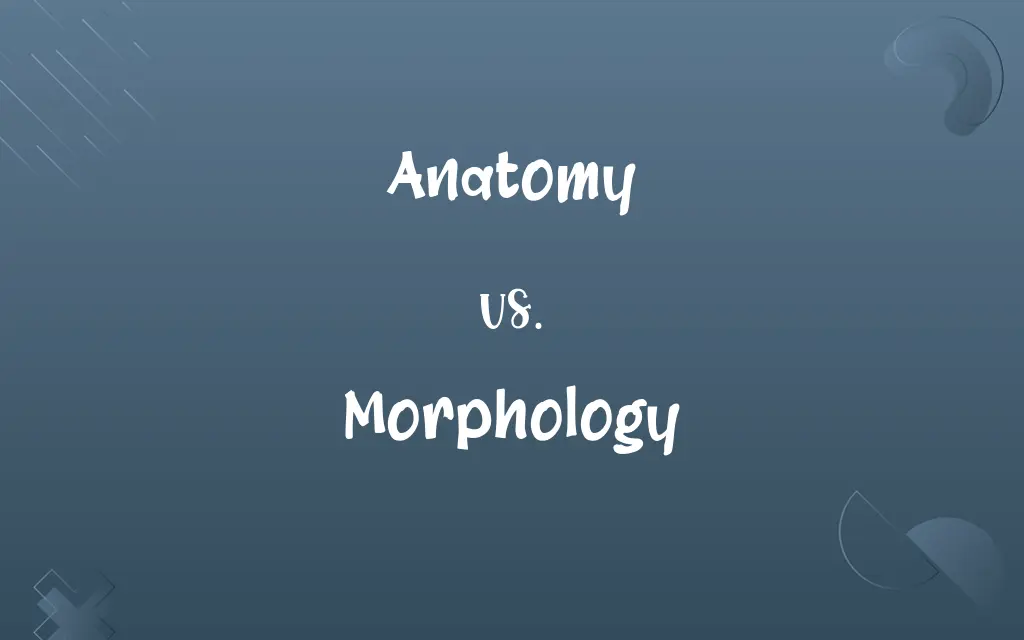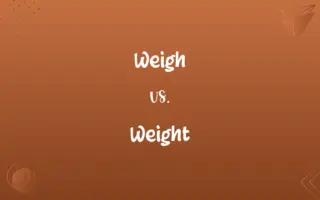Anatomy vs. Morphology: Know the Difference

By Shumaila Saeed || Updated on December 25, 2023
Anatomy is the study of internal and external physical structures of organisms, Morphology examines form, shape, and structure, including scale variations.

Key Differences
Anatomy involves dissecting and analyzing the physical structures of living organisms, examining internal organs, bones, and tissues. Morphology, on the other hand, focuses on the broader study of organism forms, encompassing not only anatomical structures but also their evolutionary and functional aspects.
Shumaila Saeed
Nov 21, 2023
While anatomy provides insight into how various parts of an organism are interconnected and function, morphology extends to the study of these forms across different species, understanding how they adapt and evolve. Morphology thus often delves into comparative analysis, unlike the more specific focus of anatomy.
Shumaila Saeed
Nov 21, 2023
In anatomy, the approach is often microscopic, delving into minute details of organism structures, such as cells and tissues. Morphology, in contrast, can include macroscopic studies, analyzing shapes and structures visible to the naked eye, making it a broader field.
Shumaila Saeed
Nov 21, 2023
Anatomy is crucial in medical and biological sciences for understanding the physical functioning of organisms. Morphology contributes significantly to taxonomy and evolutionary biology, helping classify organisms based on structural similarities and differences.
Shumaila Saeed
Nov 21, 2023
Anatomy often requires invasive methods for studying internal structures, like dissection. In contrast, morphology can be studied both through direct observation and through non-invasive techniques, making it applicable in various fields like paleontology and anthropology.
Shumaila Saeed
Nov 21, 2023
ADVERTISEMENT
Comparison Chart
Focus
Internal and external structures of organisms
Form, shape, and structural variations of organisms
Shumaila Saeed
Nov 21, 2023
Scale of Study
Microscopic (cells, tissues) to macroscopic
Mostly macroscopic, including evolutionary patterns
Shumaila Saeed
Nov 21, 2023
Application
Crucial in medicine, biology
Important in taxonomy, evolutionary biology
Shumaila Saeed
Nov 21, 2023
ADVERTISEMENT
Anatomy and Morphology Definitions
Anatomy
Anatomy refers to the bodily structure of living organisms.
Medical students study human anatomy to understand the body's systems.
Shumaila Saeed
Nov 21, 2023
Morphology
Morphology is the study of the forms and structures of plants and animals.
Morphology helps scientists understand evolutionary relationships among species.
Shumaila Saeed
Nov 21, 2023
Anatomy
Anatomy is the branch of biology concerned with the study of the structure of organisms and their parts.
Anatomy classes often include dissections to observe internal structures.
Shumaila Saeed
Nov 21, 2023
Morphology
Morphology refers to the form and structure of organisms, including their specific structural features.
Bird beak morphology varies widely, reflecting different feeding habits.
Shumaila Saeed
Nov 21, 2023
Anatomy
Anatomy can also mean a detailed analysis or structure of a subject.
The book provided a detailed anatomy of the political system.
Shumaila Saeed
Nov 21, 2023
ADVERTISEMENT
Morphology
In linguistics, morphology is the study of the forms of words, including inflection, derivation, and composition.
Morphology examines how words change form to express different grammatical categories.
Shumaila Saeed
Nov 21, 2023
Anatomy
Anatomy is the study of the structure and relationships between body parts.
The anatomy of the human heart is complex and essential for its function.
Shumaila Saeed
Nov 21, 2023
Morphology
Morphology, in a broader sense, refers to a study of the structure or form of something.
The morphology of the sculpture was both intricate and abstract.
Shumaila Saeed
Nov 21, 2023
Anatomy
In everyday use, anatomy refers to the physical makeup or structure of something.
The anatomy of the building was designed for efficiency and aesthetics.
Shumaila Saeed
Nov 21, 2023
Morphology
The branch of biology that deals with the form and structure of organisms without consideration of function.
Shumaila Saeed
Oct 19, 2023
Anatomy
The bodily structure of a plant or an animal or of any of its parts.
Shumaila Saeed
Oct 19, 2023
Morphology
The form and structure of an organism or one of its parts
The morphology of a cell.
The morphology of vertebrates.
Shumaila Saeed
Oct 19, 2023
Anatomy
The science of the shape and structure of organisms and their parts.
Shumaila Saeed
Oct 19, 2023
Morphology
(Linguistics) The study of the structure and form of words in language or a language, including inflection, derivation, and the formation of compounds.
Shumaila Saeed
Oct 19, 2023
Morphology
(uncountable) A scientific study of form and structure, usually without regard to function. Especially:
Shumaila Saeed
Oct 19, 2023
Anatomy
Dissection of a plant or animal to study the structure, position, and interrelation of its various parts.
Shumaila Saeed
Oct 19, 2023
Morphology
(linguistics) The study of the internal structure of morphemes (words and their semantic building blocks).
Shumaila Saeed
Oct 19, 2023
Morphology
(biology) The study of the form and structure of animals and plants.
Shumaila Saeed
Oct 19, 2023
Anatomy
The art of studying the different parts of any organized body, to discover their situation, structure, and economy.
Shumaila Saeed
Oct 19, 2023
Anatomy
The science that deals with the form and structure of organic bodies; anatomical structure or organization.
Animal anatomy is also called zootomy; vegetable anatomy, phytotomy; and human anatomy, anthropotomy.
Shumaila Saeed
Oct 19, 2023
Morphology
(countable) A description of the form and structure of something.
Shumaila Saeed
Oct 19, 2023
Morphology
That branch of biology which deals with the structure of animals and plants, treating of the forms of organs and describing their varieties, homologies, and metamorphoses. See Tectology, and Promorphology.
Shumaila Saeed
Oct 19, 2023
Anatomy
(by extension) The act of dividing anything, corporeal or intellectual, for the purpose of examining its parts.
The anatomy of a discourse
The anatomy of love
Burton's famous treatise, "The Anatomy of Melancholy"
Shumaila Saeed
Oct 19, 2023
Anatomy
(colloquial) The form of an individual.
I went to the Venice beach body-building competition and noticed the competitor from Athens, and let me tell you, that's what I call classic Greek anatomy.
Shumaila Saeed
Oct 19, 2023
Morphology
The branch of linguistics which studies the patterns by which words are formed from other words, including inflection, compounding, and derivation.
Shumaila Saeed
Oct 19, 2023
Anatomy
(euphemism) The human body, especially in reference to the private parts.
Shumaila Saeed
Oct 19, 2023
Morphology
The study of the patterns of inflection of words or word classes in any given language; the study of the patterns in which morphemes combine to form words, and the rules for combination; morphemics; as, the morphology of Spanish verbs; also, the inflection patterns themselves.
Shumaila Saeed
Oct 19, 2023
Morphology
The branch of biology that deals with the structure of animals and plants
Shumaila Saeed
Oct 19, 2023
Anatomy
The physical or functional organization of an organism, or part of it.
Shumaila Saeed
Oct 19, 2023
Anatomy
The art of dissecting, or artificially separating the different parts of any organized body, to discover their situation, structure, and economy; dissection.
Shumaila Saeed
Oct 19, 2023
Anatomy
The science which treats of the structure of organic bodies; anatomical structure or organization.
Let the muscles be well inserted and bound together, according to the knowledge of them which is given us by anatomy.
Shumaila Saeed
Oct 19, 2023
Morphology
The branch of geology that studies the characteristics and configuration and evolution of rocks and land forms
Shumaila Saeed
Oct 19, 2023
Morphology
Morphology can also pertain to the branch of geology that studies the configuration and evolution of landforms.
Coastal morphology studies how beaches and coastlines evolve over time.
Shumaila Saeed
Nov 21, 2023
Anatomy
The act of dividing anything, corporeal or intellectual, for the purpose of examining its parts; analysis; as, the anatomy of a discourse.
Shumaila Saeed
Oct 19, 2023
Anatomy
A skeleton; anything anatomized or dissected, or which has the appearance of being so.
The anatomy of a little child, representing all parts thereof, is accounted a greater rarity than the skeleton of a man in full stature.
They brought one Pinch, a hungry, lean-faced villain,A mere anatomy.
Shumaila Saeed
Oct 19, 2023
Anatomy
Alternative names for the body of a human being;
Leonardo studied the human body
He has a strong physique
The spirit is willing but the flesh is weak
Shumaila Saeed
Oct 19, 2023
Repeatedly Asked Queries
How are Anatomy and Morphology related?
Both are concerned with biological structures, but anatomy is more about internal structures while morphology includes external forms.
Shumaila Saeed
Nov 21, 2023
Does Morphology contribute to taxonomy?
Yes, it's crucial in classifying organisms based on structural similarities and differences.
Shumaila Saeed
Nov 21, 2023
What is Anatomy?
Anatomy is the study of the physical structure of organisms, including their internal systems.
Shumaila Saeed
Nov 21, 2023
Is Anatomy important in medicine?
Yes, understanding human anatomy is fundamental in medical science for diagnosing and treating diseases.
Shumaila Saeed
Nov 21, 2023
Is Morphology significant in evolution studies?
Yes, it helps understand how species evolve and adapt structurally.
Shumaila Saeed
Nov 21, 2023
Are dissections only related to Anatomy?
Mostly, as dissections are used to study internal structures, a key aspect of anatomy.
Shumaila Saeed
Nov 21, 2023
What does Morphology focus on?
Morphology focuses on the form and structure of organisms, including shape, size, and structural variations.
Shumaila Saeed
Nov 21, 2023
Can Morphology be applied to non-living things?
Yes, in a broader sense, morphology can refer to the form and structure of any object, not just living organisms.
Shumaila Saeed
Nov 21, 2023
Does Morphology include the study of cells?
Typically, morphology refers to structures at a larger scale than cells, focusing on overall forms and features.
Shumaila Saeed
Nov 21, 2023
Can Anatomy be self-taught?
Basic anatomy can be self-taught, but advanced study usually requires formal education.
Shumaila Saeed
Nov 21, 2023
How does Anatomy help in surgery?
Surgeons must understand anatomy to safely and effectively operate.
Shumaila Saeed
Nov 21, 2023
Are there different branches of Morphology?
Yes, including animal morphology, plant morphology, and linguistic morphology.
Shumaila Saeed
Nov 21, 2023
Can Anatomy be studied non-invasively?
Modern techniques like MRI and CT scans allow for non-invasive study of anatomy.
Shumaila Saeed
Nov 21, 2023
Is Anatomy only about human bodies?
No, it includes the study of all living organisms' structures.
Shumaila Saeed
Nov 21, 2023
Are Anatomy and Morphology exclusive to biology?
While primarily biological fields, their principles can apply to other areas like architecture and art.
Shumaila Saeed
Nov 21, 2023
Is Morphology relevant in language studies?
Yes, especially in linguistics, morphology studies the structure and formation of words.
Shumaila Saeed
Nov 21, 2023
Can Morphology predict evolutionary trends?
It can provide insights but not definitive predictions about future evolutionary paths.
Shumaila Saeed
Nov 21, 2023
Does Anatomy focus on function as well as structure?
Yes, it examines how bodily structures function and interrelate.
Shumaila Saeed
Nov 21, 2023
Does Morphology include microscopic structures?
It primarily focuses on macroscopic structures but can include microscopic aspects in certain contexts.
Shumaila Saeed
Nov 21, 2023
Do Anatomy and Morphology overlap with other sciences?
Yes, they intersect with disciplines like genetics, physiology, and ecology.
Shumaila Saeed
Nov 21, 2023
Share this page
Link for your blog / website
HTML
Link to share via messenger
About Author
Written by
Shumaila SaeedShumaila Saeed, an expert content creator with 6 years of experience, specializes in distilling complex topics into easily digestible comparisons, shining a light on the nuances that both inform and educate readers with clarity and accuracy.








































































